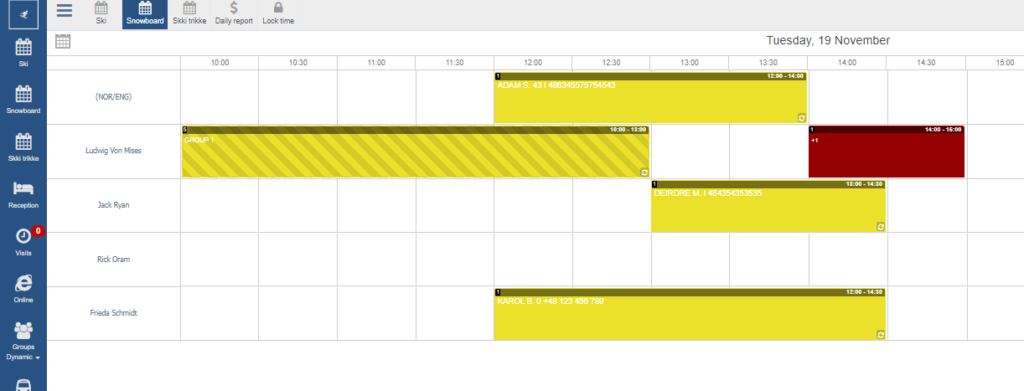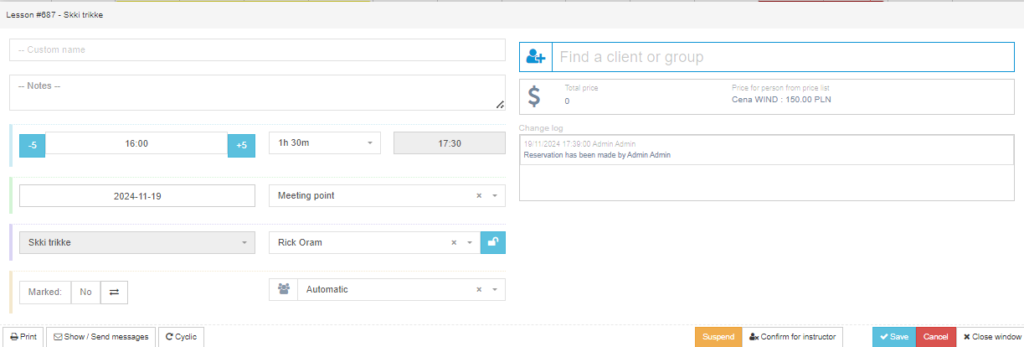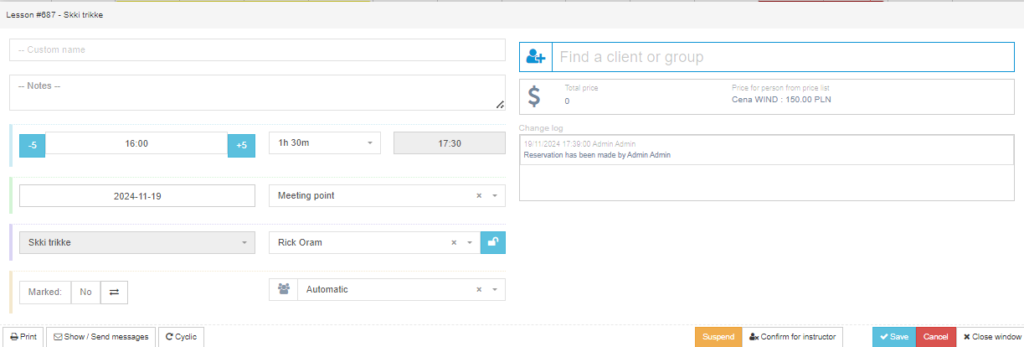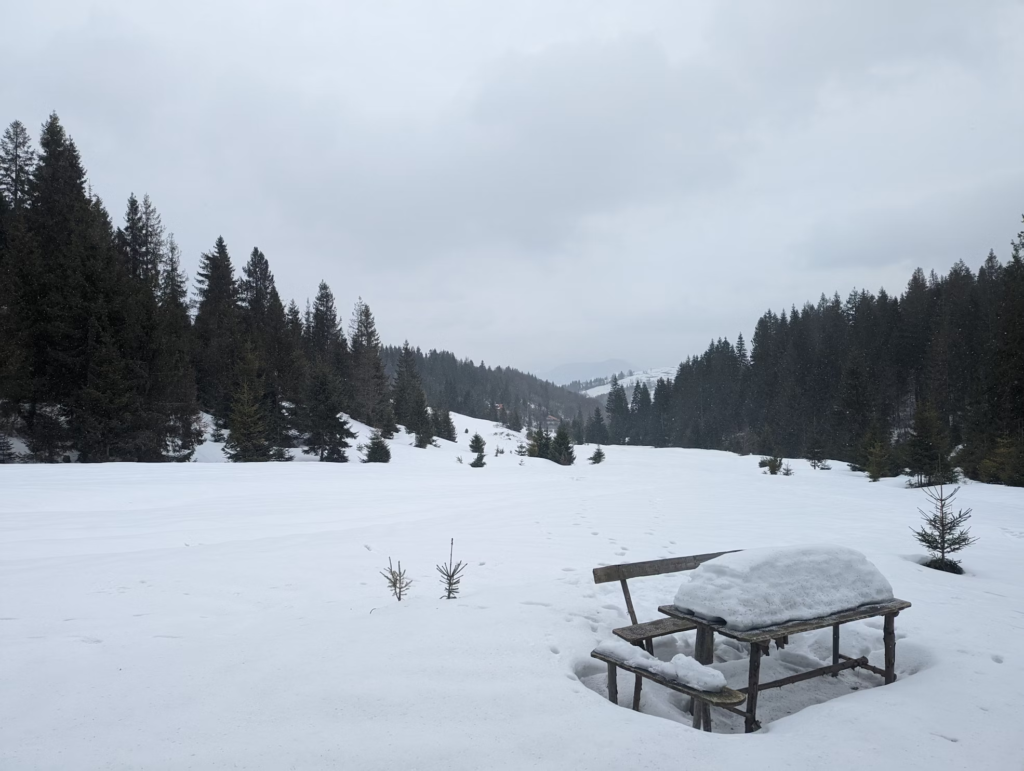How ski school software works? Overview of skiManager

How to manage daily operations in ski school?
Running a sports school—whether for skiing, snowboarding, or other activities—comes with daily organizational, financial, and communication challenges. SkiManager is a system that automates and simplifies these processes, allowing you to focus on the core aspects of your business. In this article, we’ll take a detailed look at SkiManager’s features and show you how to use this tool effectively.
Table of Contents
Introduction to SkiManager
SkiManager is a comprehensive software solution designed for sports schools. It’s not just a booking tool—it’s a platform that supports every aspect of school management, from organizing schedules and managing clients to handling finance, with a great booking tool of course.

Key Features of SkiManager
- Online bookings – 24/7 availability for clients, with automated reminders and online payments.
- Calendars and schedules – Manage instructor availability and class schedules.
- Client management – A database with booking history, automatic notifications, and personalized services.
- Financial management – Reports, statistics, and automated instructor payments.
- Rental and shop integration – Sync with additional services offered by your school.
Each of these features is easily accessible and intuitive, making SkiManager a tool for both experienced administrators and newcomers to the industry.

Practical Scenarios for Using SkiManager
Scenario 1: Organizing Class Schedules
Imagine you manage a ski school offering downhill, snowboarding, and cross-country skiing lessons. You have 10 instructors, each specializing in different disciplines.
- The problem without SkiManager: Reception staff struggles to manage instructor availability. One instructor is mistakenly double-booked for two lessons at the same time.
- The solution with SkiManager: Each discipline has its own calendar. If an instructor is available for multiple disciplines, the system shows their engagements across all disciplines. Additionally, a master schedule provides an overview of all instructors, disciplines, and classes, preventing double-booking.
Example in action: The receptionist notices that instructor John Smith has a skiing lesson at 10:00 AM and a snowboarding lesson at 11:30 AM. On the master schedule, they see that John is free in between, allowing them to book another lesson during that window.
Scenario 2: Online Bookings
Your school wants to enable clients to book lessons online.
- The problem without SkiManager: Clients must call or email, leading to chaos and booking errors.
- The solution with SkiManager: SkiManager integrates with your website, allowing clients to book lessons online. The system automatically assigns clients to available instructors and sends confirmations and reminders.
Example in action: A client books a skiing lesson for Saturday at 3:00 PM. The system sends an automatic confirmation via email and a reminder via SMS the day before the lesson. The receptionist sees the booking in the “Online” module without needing to take further action.
Scenario 3: Payment Handling
You manage many clients, each using different payment methods: cash, card, or online transfers.
- The problem without SkiManager: It’s difficult to track which lessons are paid for and which are not. Reception staff makes errors in reconciliations.
- The solution with SkiManager: The system records all payments and marks lessons as paid, overdue, or partially paid. Integration with payment operators like Przelewy24 enables clients to pay online.
Example in action: A client purchases a 10-lesson package. The system automatically applies a discount and allows payment via card or transfer. The receptionist can see the payment status in the system, eliminating the need for manual tracking.

Daily Operations in SkiManager
Key Features of the Schedule View
- Instructor Rows:
- Each row corresponds to a specific instructor (e.g., Jack Ryan, Ludwig Von Mises).
- It shows their availability and assigned lessons throughout the day.
- Time Blocks:
- The horizontal layout represents time, broken into 30-minute increments.
- Lessons or other activities are displayed as colored blocks, indicating the instructor’s engagement.
- Lesson Details:
- Each colored block represents a booked lesson. It includes:
- Client name or group name (e.g., “Group 1,” “Adam S.”).
- Contact information (e.g., phone numbers for individual clients).
- Start and end times of the lesson (e.g., 10:00–13:00).
- Additional icons or symbols (such as a circular arrow) may indicate specific lesson attributes, such as repeat lessons or changes.
- Each colored block represents a booked lesson. It includes:
- Color Coding:
- Different colors help differentiate between disciplines and lesson status
- The striped red block (“Group 1”) visually emphasizes a group lesson, making it easy to spot among other activities.
- Empty Time Slots:
- Empty cells indicate free periods for the instructor, where additional lessons or activities can be scheduled.

The color settings view in SkiManager allows administrators to customize the appearance of lessons in the calendar based on their status. This ensures better visual organization and quick identification of different lesson types. Key features include:
- Customizable Colors:
- Confirmed Lesson
- Future Lesson
- Online Future Lesson
- Lesson Done
- Lesson in Progress
- Empty Lesson
- Lesson Not Settled
- Different Discipline
This makes it easy for staff to spot lesson statuses at a glance, saving time and reducing mistakes in managing schedules.

Interactive Functionality
This view is not static—it likely allows real-time interaction. For example:
- Adding Lessons: Clicking on an empty cell allows you to create a new lesson, bringing up the lesson creation form (the lesson card).
- Rescheduling: Dragging and dropping lessons adjusts the instructor’s schedule dynamically.
- Detailed Information: Clicking on a lesson block provides access to detailed lesson information, including client profiles, payment status, and notes.
Practical Use Cases of ski School Software
The system ensures that instructors are not double-booked. For example, Ludwig Von Mises is occupied with “Group 1” from 10:00–13:00, and additional bookings during this period are impossible.
Lesson Cards

This is the lesson card in SkiManager, used to manage and edit lesson details. Key elements include:
- Lesson Details:
- Custom name and notes fields for specific lesson information.
- Start and end time, with options to adjust duration.
- Date, meeting point, discipline, and assigned instructor.
- Client Management:
- Field to assign a client or group to the lesson.
- Displays the price per person and total price.
- Change Log:
- Tracks updates or changes made to the reservation.
- Actions:
- Options to suspend the lesson, confirm it for the instructor, save changes, cancel edits, or close the window.
- Buttons for printing, sending messages, or marking the lesson as recurring (cyclic).

Reception Desk Management:
Receptionists can quickly check instructor availability to respond to client inquiries or add last-minute bookings.
For instance, Rick Oram and Jack Ryan appear to be free most of the day, making them available for additional lessons.
Instructor Coordination:
Instructors can view their schedules at a glance, ensuring clarity about their commitments and breaks.
Client Management:
By clicking on a specific lesson (e.g., Adam S. at 12:00–14:00), the receptionist can access client contact details to confirm attendance or discuss changes.
Conflict Prevention:
Adding new lessons is simple and intuitive. Just click on the schedule and drag the mouse to open the lesson card. You can set:
- Date, time, location, and instructor.
- Number of participants and their contact details.
- Lesson costs and additional services (e.g., equipment rental).
The system allows you to print the card, send messages, and set recurring lessons.
Example in action: An instructor notices that a client wants to book additional lessons after completing their first course. The receptionist opens the lesson card, schedules the new dates, and automatically assigns the client to an existing package.
Reception and Related Modules
The reception module is the heart of daily operations. From here, staff can:
- Manage client visits (current, past, and future).
- Add new clients and assign them to groups.
- Process payments and settle overdue lessons.
The reception module integrates with schedules, ensuring smooth coordination of tasks.
Example in action: A client arrives for a lesson but forgets to pay for a previous course. The receptionist sees this in the “Debtor List” module and can quickly resolve the issue.
Reports and Analytics
The system generates daily reports on revenue, expenses, and statistics. School owners can analyze these reports to better manage their business.
Example in action: After the winter season, the owner reviews SkiManager reports to see which disciplines were most popular. Based on this data, they decide to hire more snowboarding instructors for the next season.

Personalization and Extensions
Interface Design
SkiManager allows you to tailor the interface to your needs:
- A sidebar with quick access to schedules, reception, and administrative modules.
- A workspace with dynamic views.
- A top bar with icons for adding clients, sending messages, and searching for instructors.
Example in action: The reception team needs a clearer schedule view for peak season. The administrator adjusts the interface settings to display more details, such as client levels or payment statuses.
Integration with Rental and Shop
If your school offers additional services like equipment rental or product sales, SkiManager integrates these into the booking system.
Example in action: A client books a skiing lesson and rents skis simultaneously. The system adds the rental cost to the booking and automatically updates the equipment inventory.
Why Choose SkiManager?
- Process Automation
With automated reminders, reports, and payment integration, you save time and reduce errors. - Flexibility
The system adapts to your needs—you can customize schedules, calendars, and payment terms. - Transparency and Control
All information is accessible in one place, making it easier to manage operations during peak seasons. - Support for Clients and Staff
The intuitive interface and online accessibility improve the client experience and simplify staff workflows.
Conclusion
SkiManager is a tool that revolutionizes the way sports schools are managed. Its features help optimize daily operations, increase efficiency, and improve client satisfaction. Whether you manage a large school with many instructors or a small local operation, SkiManager adapts to your needs. If you’re not using this tool yet, take the first step and see how it can transform your business.

